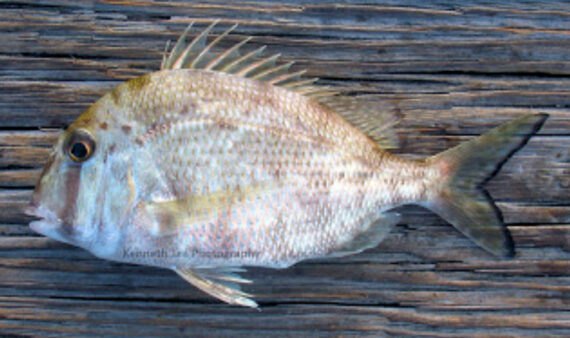Whitebone Porgy, Calamus leucosteus
 Whitebone Porgy, Calamus leucosteus. Fish caught from Anglin’s Fishing Pier, Lauderdale-by-the-Sea, Florida, April 2015. Length: 31 cm (12 inches). Catch, photograph and identification courtesy of Kenneth Tse, Toronto, Ontario, Canada.
Whitebone Porgy, Calamus leucosteus. Fish caught from Anglin’s Fishing Pier, Lauderdale-by-the-Sea, Florida, April 2015. Length: 31 cm (12 inches). Catch, photograph and identification courtesy of Kenneth Tse, Toronto, Ontario, Canada.
The Whitebone Porgy, Calamus leucosteus, is a member of the Porgy or Sparidae Family, and is known in Mexico as pluma golfina. Globally, there are thirteen species in the genus Calamus, of which nine found in Mexican waters, eight in the Atlantic, and one in the Pacific Ocean.
The Whitebone Porgy is characterized by their “porgy-like” laterally compressed, relatively deep body with a depth that is 44% to 48% of standard length and is deepest at the base of the beginning of the dorsal fin. Overall they have a silvery coloration with iridescent blue and irregular purple-gray blotches or 5 dark bars on the sides. Their fins are dusky and their caudal fin has a dark margin. Their snout is purple-gray and they have an iridescent dark blue line both under and above the eyes. Their head is deep with a moderately sloped deep head profile, a large mouth with thick lips, and a heavy lower jaw equipped with equal sized canines in the front, and molar teeth on the side. Their anal fin has 3 short spines and 9 to 11 rays and has a short base; their caudal fin is forked; their dorsal fin has 11 to 13 spines and 11 to 13 rays and is low; and, their pectoral fins have 15 rays and are long. They are covered with scales.
The Whitebone Porgy is a common coastal species and are abundant throughout most of their range. They are found over sand and mud bottoms at depths between 10 m (33 feet) and 100 m (330 feet). They reach a maximum of 46 cm (18 inches) in length, and 2.3 kg (5 lbs 0 oz) in weight with larger fish found at greater depths. As of January 1, 2024, the International Game Fish Association world record stood at 2.04 kg (4 lbs 8 oz) with the fish caught in coastal waters off Florida in May 2021. They are bottom dwellers that feed primarily on invertebrates including barnacles, crabs, mollusks, polychaetes, sea stars, and sea urchins. They are protogynous hermaphrodites with all fish starting out as females and changing to males at midlife. Each female releases between 30,000 and 1,600,00 eggs in annual cycles, which are fertilized externally by males and then become pelagic. They have life spans of twelve years. The Whitebone Porgy is poorly studied with very limited information available about their lifestyle and behavioral patterns including specific details on age, growth, longevity, movement patterns, diet, habitat use, and reproduction.
The Whitebone Porgy is a resident of all Mexican waters of the Atlantic Ocean within the Gulf of Mexico. They are absent in the Caribbean, south of Cancun on the East Coast of the Yucatán.
The Whitebone Porgy is very similar to and can be easily confused with the the Grass Porgy, Calamus arctifrons (five to seven dark bars on body that extend onto the fins), the Jolthead Porgy, Calamus bajonado (scales with brassy edges; corner of mouth dark orange), the Knobbed Porgy, Calamus nodosus (snout purplish with many yellowish to bronze spots), the Littlehead Porgy, Calamus proridens (broad pale blue horizontal band at top of gill opening), and the Saucereye Porgy, Calamus calamus (small blue spot at upper pectoral-fin base).
From a conservation perspective the Whitebone is currently considered to be of Least Concern with stable, widely distributed populations. Their fishery is unregulated in most parts of their range (except for coastal waters of the southeast United States). It is generally believed that catch levels as well as their body length have decreased over the last ten years, although these findings have been poorly documented. They are subject to habitat destruction and overfishing in some parts of their range. They are caught primarily by hook and line and via trawls. They are considered to be an excellent food fish and marketed both fresh and frozen, however, there are reports that they contain ciguatoxin. They are also targeted by recreational fishermen.